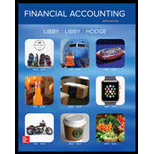
Compute the given ratios for Company C.
Answer to Problem 13.12E
The ratios of Company C are given below:
| Ratios determined for Company C | |
| Receivable turnover | 8.98 |
| Inventory turnover | 10.74 |
| 2.06 | |
| Cash ratio | 0.81 |
| Times interest earned | 9.43 |
| Cash coverage ratio | 9.35 |
Table (1)
Explanation of Solution
Receivables turnover ratio: Receivables turnover ratio is mainly used to evaluate the collection process efficiency. It helps the company to know the number of times the
Inventory turnover ratio: Inventory turnover ratio is one of the Assets Turnover ratios. This ratio is a financial metric used by a company to quantify the number of times inventory is used or sold during the accounting period. It is calculated as follows:
Current ratio: Current ratio is one of the
Cash ratio: This ratio is used to measure the adequacy of the cash in the business. It is determined by dividing cash and cash euqivalents and current liabilities. It is determined by the following formula:
Times interest earned ratio: Times interest earned ratio quantifies the number of times the earnings before interest and taxes can pay the interest expense. First, determine the sum of income before income tax and interest expense. Then, divide the sum by interest expense. It is determined by the following formula:
Cash coverage ratio: This ratio indicates the relationship between the
Determine the given ratios for Company C:
| Ratio | Formula | Calculation | Result |
| Receivable turnover | 8.98 | ||
|
Inventory turnover | 10.74 | ||
| Current ratio | 2.06 | ||
| Cash ratio | 0.81 | ||
| Times interest earned | 9.43 | ||
| Cash coverage ratio | 9.35 |
Table (2)
Working Note:
Determine the amount of average net receivables.
Determine the amount of average inventory.
Determine the amount of current assets.
Determine the amount of current liabilities.
Want to see more full solutions like this?
Chapter 13 Solutions
Financial Accounting
- Assuming no safety stock, what is the re-order point (R) given an average daily demand of 65 units, a lead time of 8 days, and 720 units on hand?arrow_forwardPlease provide answer this financial accounting questionarrow_forwardAssuming no safety stock, what is the re-order point (R) given an average daily demand of 65 units, a lead time of 8 days, and 720 units on hand? HELParrow_forward
 Managerial AccountingAccountingISBN:9781337912020Author:Carl Warren, Ph.d. Cma William B. TaylerPublisher:South-Western College Pub
Managerial AccountingAccountingISBN:9781337912020Author:Carl Warren, Ph.d. Cma William B. TaylerPublisher:South-Western College Pub Financial And Managerial AccountingAccountingISBN:9781337902663Author:WARREN, Carl S.Publisher:Cengage Learning,
Financial And Managerial AccountingAccountingISBN:9781337902663Author:WARREN, Carl S.Publisher:Cengage Learning, Survey of Accounting (Accounting I)AccountingISBN:9781305961883Author:Carl WarrenPublisher:Cengage Learning
Survey of Accounting (Accounting I)AccountingISBN:9781305961883Author:Carl WarrenPublisher:Cengage Learning Cornerstones of Financial AccountingAccountingISBN:9781337690881Author:Jay Rich, Jeff JonesPublisher:Cengage Learning
Cornerstones of Financial AccountingAccountingISBN:9781337690881Author:Jay Rich, Jeff JonesPublisher:Cengage Learning




